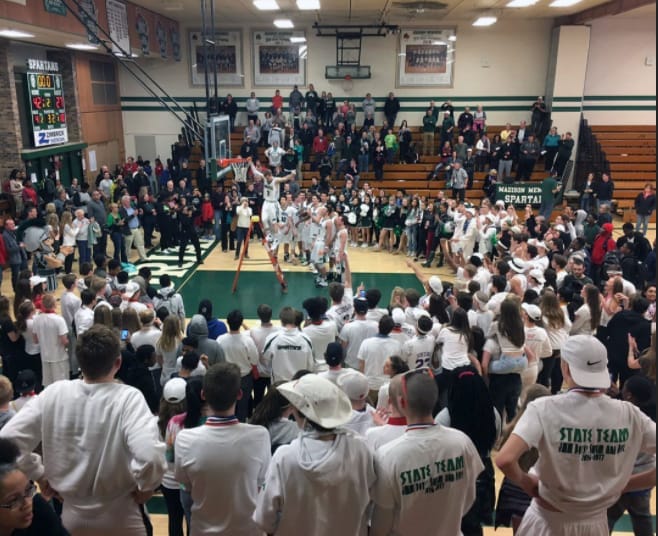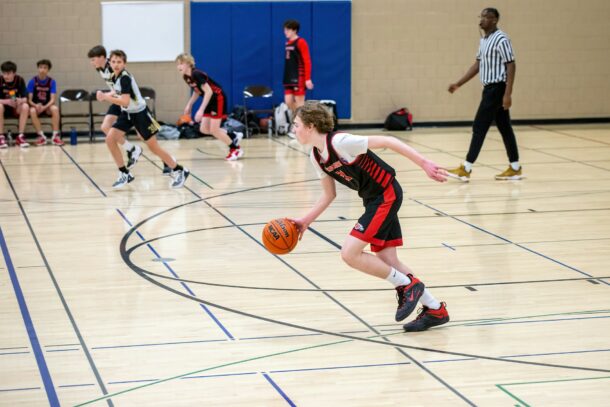If your players only practice clean looks, they struggle the moment a defender crowds their vision. The distracted shooting drill builds comfort shooting through visual clutter. It is simple to run, affordable to set up, and maps closely to what players see in games.
Why the distracted shooting drill works
When a shooter briefly loses sight of the rim, even for a fraction of a second, accuracy drops. Research on visual occlusion shows that if vision is blocked during the final ~350 milliseconds before release, performance suffers, while having vision restored in those final ~350 milliseconds preserves accuracy.
You can see this principle in the pros. The “Kornet Contest” is a good example, where a 7-footer jumps to momentarily block the shooter’s view. On those shots, opponents made 33.3%, compared with the league-wide “wide-open” average of about 38%. Obscuring vision, even from several feet away, can matter.
Biomechanics studies add detail. When players shoot over higher obstacles, they jump higher and alter entry angles, and their make rate declines compared with smaller obstacles. Training that experience in practice prepares players for real contests.
Finally, teaching athletes where and how to look helps them manage distraction. Quiet-eye training, which stabilizes gaze on a single target location, improves shooting accuracy and transfers under defensive pressure.
Equipment
- 1–2 pool noodles or a light broom handle
- 1 ball per shooter
- 1 partner or coach as the “distractor”
Pool noodles are safe, light, and easy for younger players to handle as they simulate a defender’s hand without contact.
Core distracted shooting drill
Goal: Normalize shooting with a hand in your line of sight.
Setup: Shooter at a wing or elbow. Partner stands an arm’s length away, holding a noodle or hand up to the shooter’s eye line.
How to run it
- Catch and shoot with a contest
- Partner lifts the noodle to the shooter’s eyeline as the ball arrives.
- Shooter locks eyes on the rim through or around the “hand,” then shoots.
- Make two and move
- Five spots: corner, wing, top, opposite wing, opposite corner.
- Shooter makes two at each spot, then rotates.
- Switch roles after every spot or two.
Coaching cues
- Get your eyes back to the rim early.
- Freeze the gaze on one part of the rim before the rise.
- Smooth rise, high finish, same follow-through each time.
- The contest is visual, not physical. Keep space.
Why it maps to games: Players must reacquire the rim while a “defender” floats in their field of view, which mirrors the momentary occlusion that hurts accuracy if it occurs right before release.
Join the TeachHoops Community

TeachHoops.com offers a unique platform for coaches to share experiences and gain new insights. Learn from others who have navigated similar challenges. It’s an invaluable resource for those looking to:
- Broaden perspectives
- Refine strategies
- Enhance their leadership and motivational skills
Step into Enhanced Coaching
Win the Season: Basketball Masterclass!

Two add-ons that level it up
1) Pull-up series with distraction
- Start at half court or the logo.
- Dribble to a cone at the wing.
- Partner steps in with the noodle to the eyeline on the gather.
- Shooter plants, rises, and hits one pull-up going right, one going left, then rotate spots.
What it trains: Footwork under pressure and quick visual reacquisition at game speed. Taller or longer defenders force higher jumps and different entry angles, which this variation replicates.
2) “Bobby Knight J’s” partner drill
- Partner starts at the top with a ball.
- Shooter relocates to a spot.
- Partner passes, raises a hand or noodle to contest.
- Shooter fires, rebounds, and outlets back.
- Work five spots, make 2–3 at each.
What it trains: Rhythm into relocation, contested catches, and immediate shot prep.
Teaching the eyes: quick quiet-eye routine
Add this 10-second habit to every distracted shooting drill:
- Find the rim as the ball arrives.
- Fix your gaze on a single target on the rim.
- Keep that fixated spot through the rise and release.
Quiet-eye training produces better accuracy than technique-only instruction and holds up better when a defender adds pressure.
Common fixes
- Shots are flat when distracted
- Cue “eyes early, soft arc.” If players jump higher to clear a contest, remind them to keep the same release rhythm.
- Players rush when the hand appears
- Rehearse one calm breath and a steady gaze before the rise. Quiet-eye research supports stable focus under pressure.
- Young players shy away from the contest
- Keep distance and remind the partner this is visual only. No reach-ins, no contact.
Age-level and space adjustments
- Elementary and middle school: Use shorter distances and slower tempos. Hold the noodle higher and farther to reduce crowding.
- High school: Add drifts, lifts, and trail threes with a late contest.
- Limited space: Run two spots and alternate reps to manage traffic.
Wrap up
The distracted shooting drill teaches your players to see the rim through traffic and keep their form under pressure. Build it into daily shooting. Cycle through spots, add the pull-up series, and finish with “Bobby Knight J’s.” Anchor every rep with a steady gaze, then let the defense blur into the background.
Latest Posts
- The Ultimate Youth Basketball Dribbling Progression: 4 Foundational Drills Every Coach Should Teach
- The Only 3 Stats Youth Basketball Coaches Need
- How to Coach First-Time Youth Basketball Players the Right Way
- 7 Simple Steps toward Building Team Culture in Youth Basketball
- Master Two-Ball Dribbling Drills: Build Confidence and Control in Every Player





